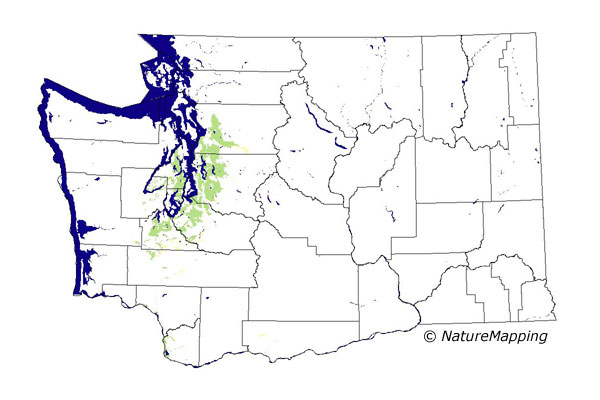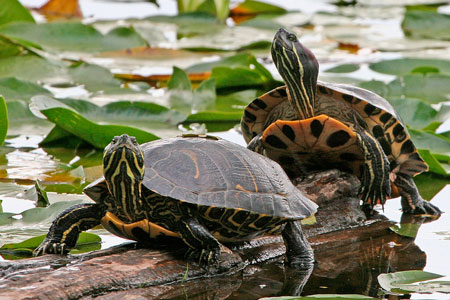


Red-eared Slider (Trachemys scripta elegans) Description: Red-eared Sliders are brightly marked, and look similar to the painted turtle. The carapace (top shell) of the Red-eared Slider is higher domed than that of the Western Painted Turtle and is weakly keeled. [ see comparison guide ] Characteristics that most obviously distinguish the Slider include yellow marginal scutes, a yellow plastron covered in dark, blotchy markings, and a red ear mark located just behind the eye (although this ear mark is not always visible in older specimens). The head, neck, and legs are greenish with yellow stripes. The olive or brown carapace usually has yellow and black longitudinal bands and stripes. The plastron (bottom shell) is yellow with a dark, rounded blotch in each scute.
Males are slightly smaller than females and have longer claws on the forefeet. Old specimens, especially males, may become very dark, with black coloration obscuring the striped pattern on the skin and shell. 
Range/ Habitat: The introduced Red-eared Slider co-occurs with the Western Painted Turtle in many areas of its range and may be confused with this species. Red-eared Sliders are one of the most common turtles in the Puget Sound area. They can be found basking in the sun around Lake Washington and ponds in Western Washington. This turtle lives in ponds, lakes, marshes, and in slow-moving rivers that have soft, muddy bottoms. Pond sliders are native to the Nearctic and Neotropical regions. They are found from the southern Great Lakes region east to West Virginia, west to Indiana and Illinois and south throughout most of the southeastern and south-central United States. The red-eared slider turtles common in the pet trade are native to only part of the United States, but are turning up where they are not native across the country and around the globe. They are now considered among the word's 100 most invasive species (The Humane Society). Click the map for information about the habitat and range of the Pond Sliders (Trachemys scripta) in Washington. Diet: Red-eared Sliders feed mainly on plants and small animals, such as crickets, fish, crayfish, snails, tadpoles, worms, aquatic insects and aquatic plants. Turtles don't have teeth, but instead have horny ridges that are serrated and sharp on their upper and lower jaws. Reproduction: The breeding season lasts from late spring to early summer. Courtship and mating activities for red-eared sliders usually occur between March and July, and take place underwater. Turtles are amniotes which requires females to nest on land. Females prefer soft, sandy soil with good exposure to the sun for their nest site. Nests are dug with the turtle's hind feet, usually within 200 meters of water. The nest is no deeper than 10 to 12 centimeters. The females will lay 2 to 30 oval, soft shelled eggs. The eggs are fertilized as they are being laid and buried in the sand. Development: The sex of the turtle is determined during a critical phase of embryogenesis according to the incubation temperature. These temperature-dependent reptiles lack sex chromosomes that determine gender. Pond slider eggs that are incubated at temperatures between 22 and 27 degrees Celsius become only males, while eggs that are incubated at warmer temperatures become females. Baby sliders hatch out of the egg looking like small adults. Behavior: Raccoons, otters, mink, foxes, and other medium-sized animals will prey on turtles and their eggs. Painted turtles keep a watch out for predators and seek refuge in the water at the first sign of danger. For protection, they can quickly retract their head and legs into their hard shell. Red-eared Sliders bask in groups on logs, fallen trees, and other objects near water (see photo). The sun exposure helps rid them of parasites. The red-eared slider is known to quickly slide off rocks and logs when approached. Reptiles do not hibernate but actually brumate, becoming less active but occasionally rising for food or water. Red-eared sliders brumate over the winter at the bottom of ponds or shallow lakes and they become inactive, generally, in October, when temperatures fall below 50 °F (10 °C).
Did you know?
Definitions: carapace - a turtle's top shell keel - a raised ridge along the middle (front to back) of the carapace of some turtles plastron - a turtle's bottom shell scute - the large, separate scales on the carapace and plastron of most turtles
More Information: Thinking of Getting a Pet Turtle? Red-eared Slider - Animal Diversity Web Painted Turtle - Animal Diversity Web Painted Turtle Facts - NatureMapping Animal silhouettes available to purchase » Photos: Alan Wilson Home | About Us | How to Participate | Biodiversity Modules | Projects | Maps | News | Resources |